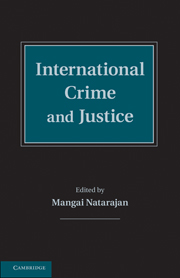Book contents
- Frontmatter
- Contents
- List of Figures
- List of Tables
- List of Contributors
- Foreword
- Preface
- Introduction
- Part I International Criminology
- Part II Law, Punishment, and Crime Control Philosophies of the World
- Part III Transnational Crime
- Part IV Organized Crime and Terrorism
- Part V International crime
- Part VI Delivering International Justice
- Part VII International Cooperation and Criminal Justice
- Part VIII International Research and Crime Statistics
- 60 The U.S. Uniform Crime Reports and the National Crime Victimization Survey
- 61 Highlights of the International Crime Victims Survey
- 62 Crossnational Comparisons Based on Official Statistics of Crime
- 63 The International Self-Report Delinquency Study (ISRD)
- 64 Criminology, Method, and Qualitative Comparative Analysis
- Part IX International research resources
- World Map
- Index
- References
61 - Highlights of the International Crime Victims Survey
Published online by Cambridge University Press: 05 October 2014
- Frontmatter
- Contents
- List of Figures
- List of Tables
- List of Contributors
- Foreword
- Preface
- Introduction
- Part I International Criminology
- Part II Law, Punishment, and Crime Control Philosophies of the World
- Part III Transnational Crime
- Part IV Organized Crime and Terrorism
- Part V International crime
- Part VI Delivering International Justice
- Part VII International Cooperation and Criminal Justice
- Part VIII International Research and Crime Statistics
- 60 The U.S. Uniform Crime Reports and the National Crime Victimization Survey
- 61 Highlights of the International Crime Victims Survey
- 62 Crossnational Comparisons Based on Official Statistics of Crime
- 63 The International Self-Report Delinquency Study (ISRD)
- 64 Criminology, Method, and Qualitative Comparative Analysis
- Part IX International research resources
- World Map
- Index
- References
Summary
BACKGROUND TO THE INTERNATIONAL CRIME VICTIM SURVEYS
Over the past three decades an increasing number of countries have undertaken “victimization surveys” among the general population about experiences of crime. These surveys provide a source of data on crime independent of crime statistics recorded by police (Maxfield, Hough, & Mayhew, 2007). They also provide important additional information on crime including rates of reporting crimes to the police, victims’ experiences with the police, fear of crime, and the use of crime prevention measures. If the research methodology used is standardized, the surveys also offer a new opportunity for the collection of crime statistics, which can be used for comparative purposes. This allows crime problems to be analyzed from a truly international perspective (Kury, 2001).
The first International Crime Victims Surveys (ICVS) took place in 1989 in a dozen countries. It has since been repeated four times in 1992, 1996, 2000, and 2005. Since its initiation, surveys have been carried out one or more times in seventy-eight countries including all twenty-seven Member states of the European Union, Australia, Canada, Japan, and The United States of America (van Dijk, van Kesteren, & Smit, 2007). More than 320,000 citizens have been interviewed to date in the course of the ICVS with the same questionnaire, translated into thirty or more languages. This process has resulted in a body of victim survey data across a variety of countries covering a period of twenty years. The full dataset is available for secondary analyses (ICVS, 2005).
- Type
- Chapter
- Information
- International Crime and Justice , pp. 462 - 470Publisher: Cambridge University PressPrint publication year: 2010

